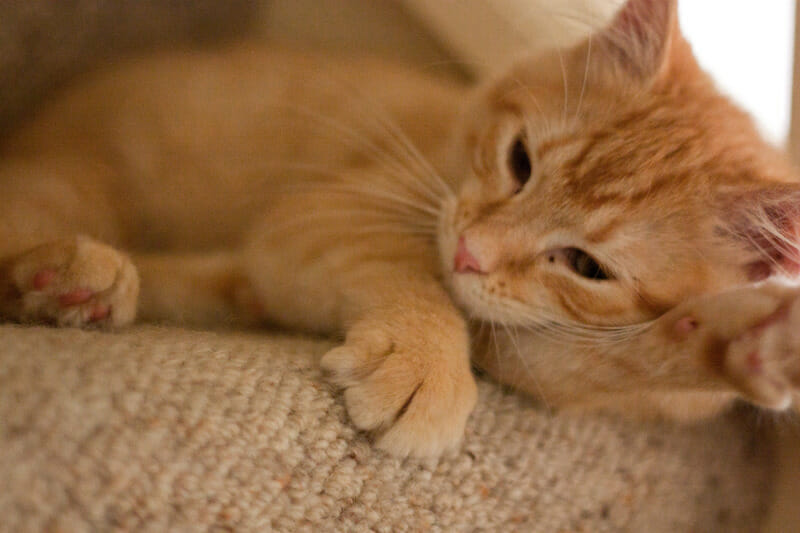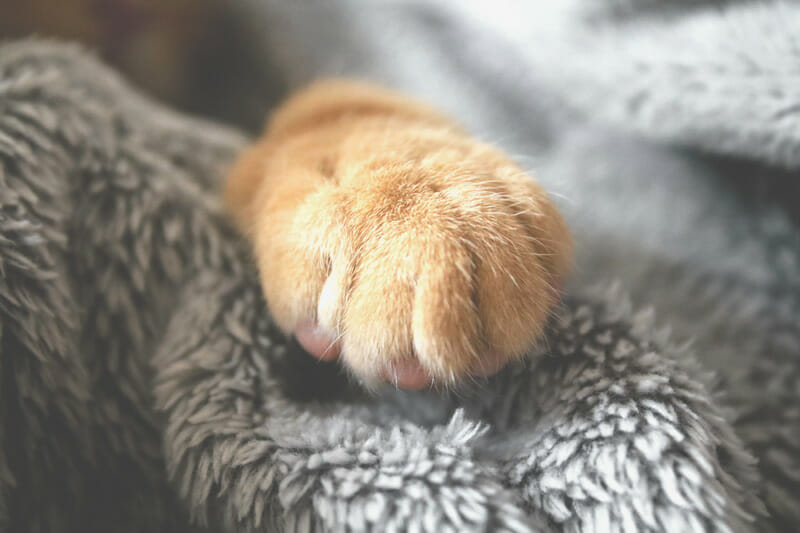Is your favourite couch scratched beyond recognition? Is your vintage carpet desperately asking to be rolled up after another destructive clawing session from your cat? If you find yourself constantly hoping your cat would stop scratching your furniture, floors, rugs, and other items, you’re in luck! We’ve done our research to find the best ways to stop your cat from scratching everything inside your home.
With this Waldo’s Friends guide, you’ll discover:
- Why cats scratch
- What and when cats scratch
- How to stop cats from scratching your furniture
- Why you should never declaw your cat
Why do cats scratch?
Scratching is not an annoying habit that kittens outgrow. It is a normal and necessary action that feline pets do for many reasons. Cats regularly scratch to get rid of the dead outer layer of their claws, to sharpen their nails, to stretch and strengthen their bodies, and to mark their territory. They succeed in marking their territory by leaving visual marks and a scent, which is released between their toes when they start scratching.
What and when do cats usually scratch?
Take a moment and think about the things your cat has destroyed in the past. Is he into scratching your upholstered sofa, the legs of your dining table, the bedroom drapes, or your bathroom rug? Cats are into scratching surfaces that are nubby, coarse, textured, or just about anything they can sink their claws into. They usually do this as soon as they wake up from a nap, when they get excited about something or someone, or when they want to own a spot.

How can I stop a cat from scratching my furniture?
Now that you know how important scratching is for a cat, you must find ways to redirect his behaviour into appropriate objects. Try any of these techniques below or combine them all:
1 Provide him with scratching posts
A scratching post is defined by Wikipedia as “a wooden post covered in rough material that cat owners provide so their pets have an acceptable place to scratch… Indoor cats may be prevented from exercising this urge on furniture if they are provided with an acceptable scratching post.”
Before purchasing a scratching post, observe your cat to find out what kind will suit him best. Answer these questions:
- What is the material of the furniture or surface that your cat likes to scratch? Is it corrugated cardboard, sisal rope, carpeting, natural wood, or something else?
- Does your cat stand up to scratch vertical surfaces like couch corners or chair legs? Or does he prefer stretching out his body horizontally and sticking his butt in the air while scratching the rug or carpet?

Aside from the material and height of the scratching post, you need to make sure that it has a wide, solid, and stable base that can withstand your cat’s body weight. If the base is too small or unsteady, it will wobble or tip over as your cat claws it and will make him lose confidence in it.
Placing the scratching post in the right spot is just as crucial as buying the right one. Situate it beside areas you find him regularly scratching: next to the front door (for a quick scratch after he welcomes you home) or beside his sleeping cot (for a good post-nap stretch). Because cats scratch to leave their scent and inform other cats that they have passed through, it’s best to position scratching posts near room entrances and sleeping areas throughout the house. And if you own more than one feline pet, make sure to set up multiple vertical and horizontal scratching posts in your home. You can buy commercially sold scratching posts or even create your own.
TIP: To make a new scratching post more appealing, rub catnip or spray catnip oil all over and let your cat’s favourite toy dangle over it. Praising and petting your cat when he scratches the post will also create positive association.
2 Protect your furniture
The battle is almost won after you’ve presented your cat with more appealing scratching options. But if you find that your cat still occasionally claws things and surfaces that he shouldn’t, you can try making them undesirable through these methods:
- Spray a non-toxic herbal scent (like citrus or menthol) over the fabric
- Place cotton balls that have been soaked in cologne or muscle rub next to non-fabric surfaces
- Apply a double-sided tape product (such as Sticky Paws) to your furniture and deters cats from touching and scratching the surface
- Cover the area with aluminum foil
- Put a plastic runner or vinyl carpet runner (with the spikes side up) over it
Besides these deterrents, you can also place a scratching post near the item he likes to claw so that you redirect his attention to the post.
3 Trim your cat’s nails
With the help of sharp trimmers, clipping your cat’s nails once every two weeks will also protect your furniture from wear and tear. Follow these simple step-by-step tips from our article, Cat grooming at home, and make sure to trim the tip (the clear part of the nail) and not the quick (the pink, fleshy part underneath the nail). Regularly check your cat’s claws to see if he needs a trim. Untrimmed claws may lead to infection, pain, and difficulty in walking or using the litter box.
TIP: Successfully clip a nail or two when your cat is asleep or when he’s feeling extra relaxed.

4 Correct his behaviour
Whenever your cat scratches an undesired spot, communicate with him by making a loud noise. Clap your hands, shake a can of pebbles, slap the wall, or make a hissing, quick “ah!” sound. Refrain from calling out his name so that he associates his name only with approved actions. After making the sound, gently carry him to the scratching post and encourage him to scratch there instead. Consistently doing this will teach him that it is bad to scratch his preferred surface, but good to scratch his post.
5 Opt to use nail caps
If your indoor cat continues to scratch everything in sight, you might want to consider placing soft, non-toxic nail caps on his claws. Soft Claws is a popular vet-developed product that can be applied over cat nails by veterinarians, animal groomers, or even pet owners themselves. Available in different sizes, colours, and designs, these nail caps can be easily attached using liquid adhesive.
Effectively blunting his claws without harming your cat nor his nail bed, the caps allow your feline pet to comfortably extend and retract his claws without harming you or your furniture. The downside to these nail caps is that they get pushed off once his nails grow (approximately after four to six weeks), so they need to be replaced regularly. This may be a costly alternative for some pet owners.
Why you should never declaw your cat
It’s important to note that no matter how destructive your cat gets, you should never choose to declaw him. Aside from the act being illegal and inhumane, declawing causes pain years after the surgery. Declawed cats need to relearn how to walk, are more likely to do their business outside their litter box, and are reported to become more aggressive than their clawed counterparts.
In conclusion
Your cat needs to scratch on a regular basis. By providing him with scratch posts all over your house, guiding him toward the right spots to scratch, and reinforcing his actions with praise, you can live in a scratch-free home with your purr-fect companion.
To learn more about responsible pet parenting, read our other guides.
Leave a comment
Your email address will not be published. All fields are required.